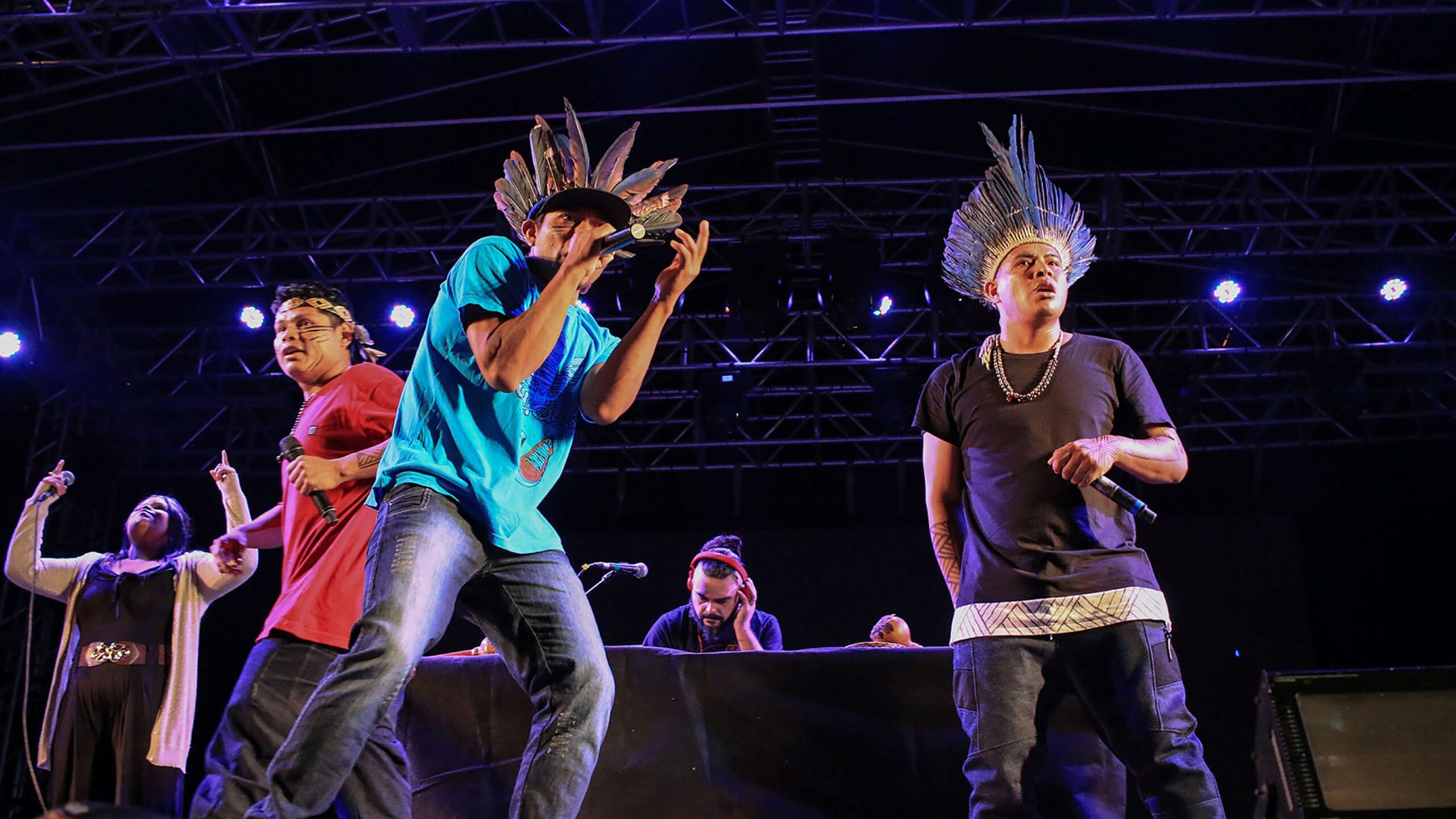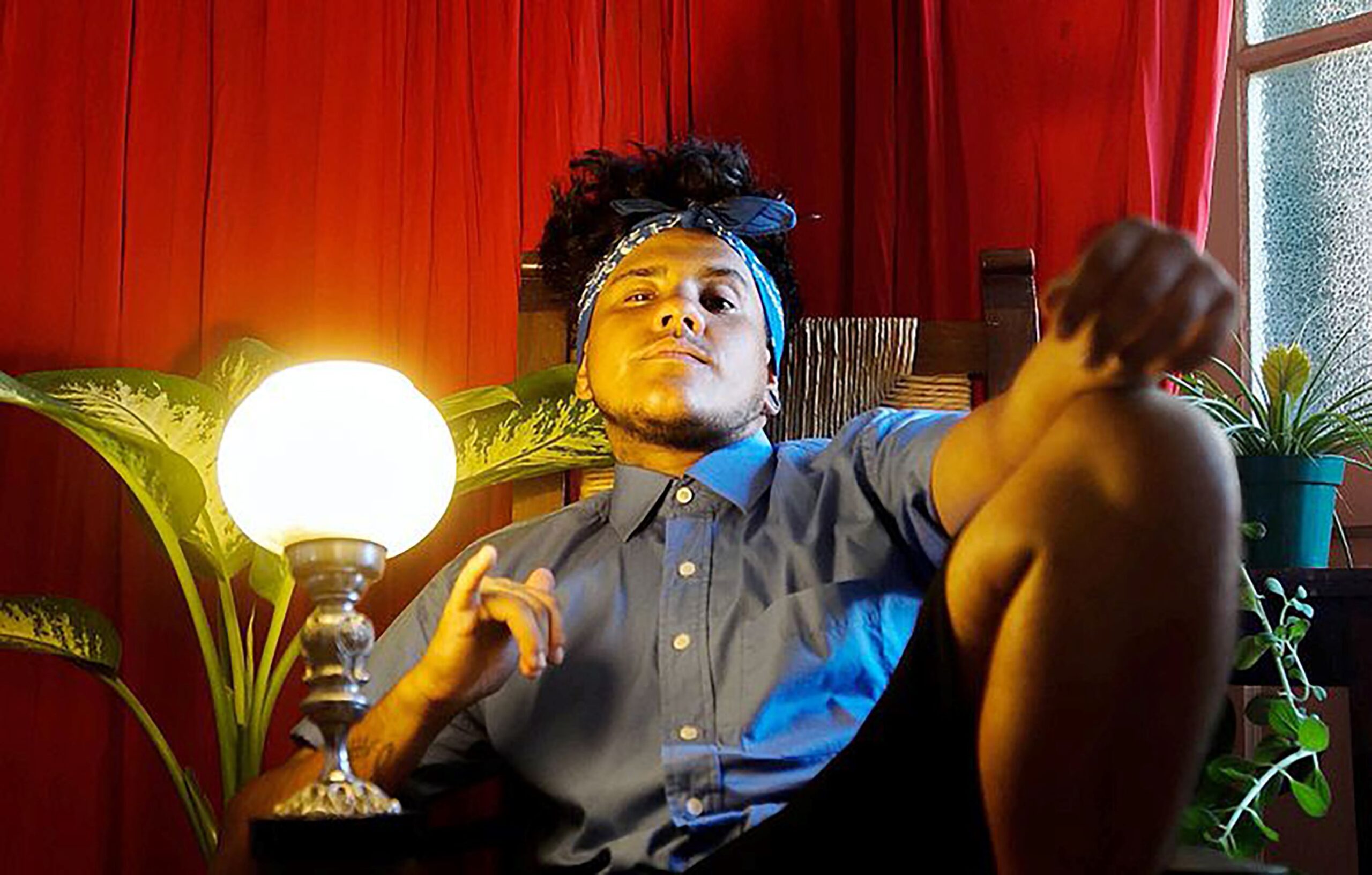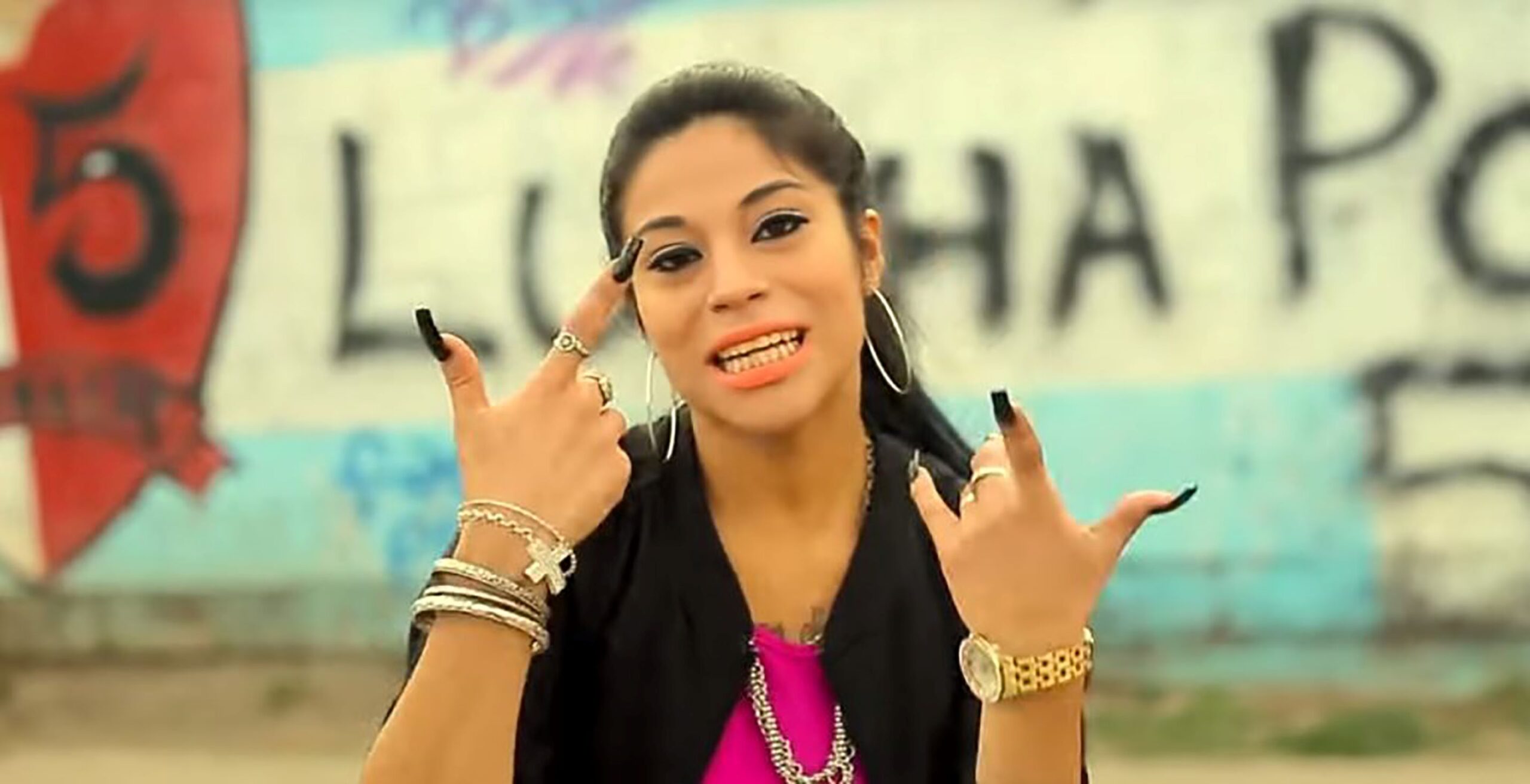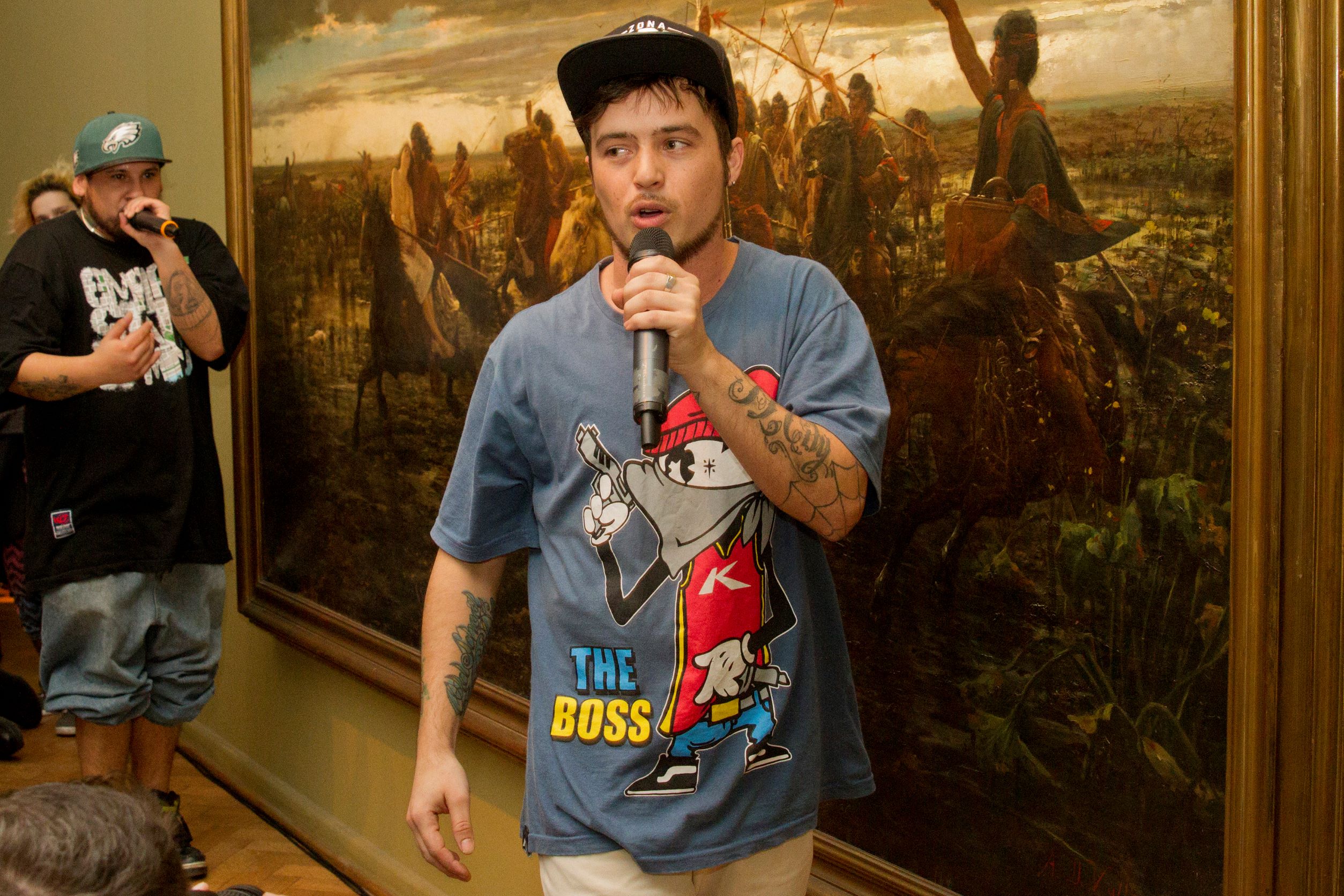
02.05.2022
On the border, between the Great Outside and the Great Inside there are fissures that detonate fixed categories, Nancy Rojas addresses these liminal spaces within language from the transforming insurgency of trap.
(…) they [the Guaraní] know that the embryos of words emerge from the fertilization of the air of time in our bodies in their condition of living and that, in this case, and only in this case, the words have soul, the soul of the present worlds or in seeds that inhabit us in this condition of ours.[1]
Suely Rolnik
My art is going to kill you and you know that terrifies you.[2]
MC Humver
A multicolored atmosphere emerges from the background of a landscape both near to and far from our gaze. It reveals an irradiant and cuir natural world, whose tonal diversity is projected in the cultural plurality of this northern space. Trap artist B Yami raps. Like the rhapsodes of Ancient Greece, she tries to generate vibrations in the horizon so her words may reach the lost ears of that land which is this same land—our land, to allow us to glimpse the sweeping power of her undulating style. Locas, tortas, travas, trans, marronas, copleras, singers, pianists, and experimental noisemakers listen attentively, forging a web of glances that amalgamate in the complicity granted by the night. To dissident sounds, spaces of incantation.
Thus, in Terminal norte (2021) Lucrecia Martel portrays a group of voices that embody music that crystallizes a certain state of liminality[3] through borderline styles and approaches. Of the genres that appear there, only one currently connects strongly with the youngest generations: trap, a music style that is today defined as a subgenre of rap rooted in so-called hip hop culture. Like other cultural practices, it was born in the heart of the Great Outdoors, i.e. the street. It was there, out in the open, that the first freestyle meetings and rap competitions were held.

It was precisely around the years of this exhibition that trap began to gain popularity in Latin America. It did so thanks to some shared principles: the fact of performing in the streets and the creation of spaces of belonging through these performances, and the impetus to generate community in neighborhoods that generated shared identities whose definition was not limited to the normative family unit.

Speaking—which is also believing, —and therefore believing, bursting out in opposition to what is normal or normalizing,
and liberating language seem to be some of the enunciative principles of trap in its preliminary state, which is also its liminal moment.
It is a kind of music that perfectly understands the flow between art and life, that grew, genealogically speaking, out of the underground and/or from life at the margins. Thus, it is at its root a subgenre that, like all expressions that are generated from the subsoil of language, evokes emancipation. It is also a genre that exists apart from the other genres that originated in the nineties in the southern United States, one that has mutated—and this is a hypothesis—to become, paradoxically, one of the most popular modes for cultural expression in South American countries. This paradoxical view is based on a question that will probably remain pertinent for several years: why talk about trap as a latent figure of popular culture at a time when it has been voraciously consumed by the mainstream music industry? Could it not be that mainstream culture has historically made use of the popular fabric to disseminate new phenomena?
These questions arise within the framework of a conviction: one that sees this transgeographic and cross-border practice as the offspring of a performative culture that has been able to persist, like so few others, as a space for disobedience and expression.

In the face of a system that has absorbed the genre and transformed it into one of the predominant styles of mass culture[4]—a situation that has its origins in the media revolution in which social networks, sponsors, and the reinvented image of success play a fundamental role—there are sectors of urban and rural youth that make a micropolitical use of this practice. In this way, they support the notions of public culture and popular culture beyond monopolistic systems and even beyond state policies. In the current era of the inexhaustible “war of images,” the underground generates its own forms of resistance—that is to say, of producing and reproducing itself in language, confronting the condition of systematization through certain more anomalous and elusive strategies of collective subjectivation.

In different Latin American countries, groups of Aymara, Quechua, Mapuche, Kaiowá, Kokama, and Quom youths have emerged, declaring a socio-political claim for their vernacular languages. As Victoria Beiras del Carril and Paola Cúneo point out, the “emergence of these rap groups formed by young people who identify as indigenous is situated in a larger global movement that has seen the dissemination of hip-hop culture throughout the world through its ability to connect with the diverse local realities and, through them, transform into manifestations of cultural hybridity that constitute instruments of contestation and struggle against different forms of oppression and marginalization.”[6]
Beyond the requirements of “metrics” and “flow” or the millions of reproductions, it is important to escape from the circuits that have popularized freestyle and look to those radically counterhegemonic examples that exist within this subgenre. I am referring to those groups that, like the aforementioned referents, use rap and its derivative trap as tools for fighting against patriarchal, colonialist, racist, and capitalist subjugation. As MC Humver, an Afro-Paraguayan transmasculine composer and singer does when he announces in his single Calentura: “I am more dangerous than a white man with a tie. I am the plague, I am the virus, the poetry that kills kills kills, the least loved person in Christianity. When my language attacks, the greatest isms emerge.” Or Nata Ly aka N. L. Y. from Santiago, Argentina, who confronts human trafficking with her lyrics in songs like Esclavas del silencio. Or B Yami, who takes on masculinity with feminist jargon derived from their experiences in the Limache neighborhood of Salta. Or collectives like the Artesanos de la verdad, a group formed by four brothers who launched their raw rap in Rosario a few years ago, rapping primarily in Qom and drawing from biographical and social stories to forge a severe criticism of the political class and the ways in which resources are managed and distributed in the country.

They constitute a matrix of thought and action that can be read in the light of the new processes of anti-colonial struggle.
Trap and rap reveal, in a way, a rupture with the limits of the polarity of dominant-dominated.
Suggested playlist:
Brô Mc’s, Kunumi Mc, OZ Guarani: Resistência Nativa –
https://open.spotify.com/track/1m841EOt9OL7K61CXzhFap?si=c0818123db36475d
Bro Mc’s: Eju Orendive
Artesanos de la verdad: Realidad Fe
Wechekeche ñi Trawün: Mapudungufinge
Alex Heduvan: La sopa de los pobres
https://mnba.bandcamp.com/track/alex-heduvan-la-sopa-de-los-pobres
Ciclo Bellos Jueves, Buenos Aires, Museo Nacional de Bellas Artes, 25 de junio de 2015. Curaduría general: Santiago Villanueva. Curaduría musical: Villa Diamante.
Alex Heduvan: La vuelta del malón
https://mnba.bandcamp.com/track/alex-heduvan-la-vuelta-del-malon
Ciclo Bellos Jueves, Buenos Aires, Museo Nacional de Bellas Artes, 25 de junio de 2015. Curaduría general: Santiago Villanueva. Curaduría musical: Villa Diamante.
Alex Heduvan: Sin pan y sin trabajo
https://mnba.bandcamp.com/track/alex-heduvan-sin-pan-y-sin-trabajo
Ciclo Bellos Jueves, Buenos Aires, Museo Nacional de Bellas Artes, 25 de junio de 2015. Curaduría general: Santiago Villanueva. Curaduría musical: Villa Diamante.
Nata Ly: Esclavas del silencio
Nata Ly: Del Estero
Nata Ly: Verde lucha
B Yami: Te queres matar
B Yami: Toa la gata
Mc Humver: Calentura
https://open.spotify.com/track/5TlgHcDIyayqBh4230E82w?si=7d507f52615a4843
Suely Rolnik, Esferas de la insurrección. Apuntes para descolonizar el insconsciente (Buenos Aires: Tinta Limón, 2019), 22.
From the song Calentura, by Afro-Paraguayan transmasculine artist, composer and singer MC Humver, released in April 2021.
Liminality connotes the threshold, the border, that which seems constant but is not. “For years I have understood the liminal to be the emergence of a mode that makes it possible to inhabit the world in a poetic and authentic way, albeit ephemerally. Liminality is inevitably linked to communitas, to the unhierarchized proximity to others, to the unregulated but vital encounter, to doing for oneself and for others, to desiring subjectivities, to the politics of desire. To what Félix Guattari called “micropolitics.” In the liminal register, the threshold is a space of transformation and encounter, and implies a certain belief, a certain disposition of spirit, a certain idea that something has to change for the better? Ileana Diéguez, Escenarios liminales. Teatralidades, Performatividades, Políticas (México: Paso de Gato, 2014), 13.
Mass culture “transcends frontiers and invades remote regions like a warm current that advances, standardizing and sweetening, promising inaccessible worlds and sowing promiscuous dreams. Made by the great economic corporations and produced by “specialized executors,” it descends to the majorities and distracts them with its transparent messages and its easy beauty, with models impossible to be referred to any concrete experience or converted into an indication of other truths.” Ticio Escobar, El mito del arte y el mito del pueblo. Cuestiones sobre arte popular (Buenos Aires: Ariel, 2014), 103.
Suely Rolnik, op. cit., 28.
Victoria Beiras del Carril and Paola Cúneo, “Haciendo un freestyle con los qompas: juegos verbales y recontextualización de géneros discursivos en el rap qom,m” Journal de la Société des américanistes (2020): 133.http://journals.openedition.org/jsa/17901
Ticio Escobar, op. cit., 109-110.
Cf. Néstor García Canclini, “La puesta en escena de lo popular” in Culturas híbridas. Estrategias para entrar y salir de la modernidad (Buenos Aires, Paidos, 2001), 206.
Comments
There are no coments available.